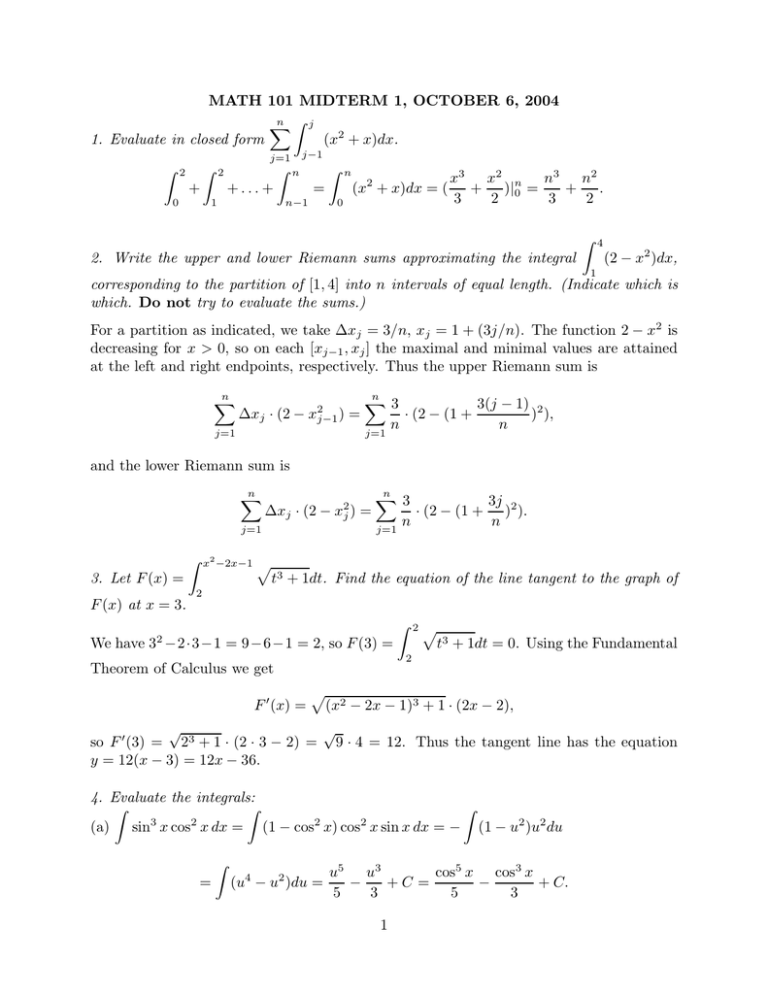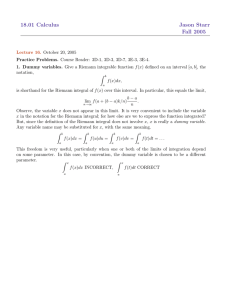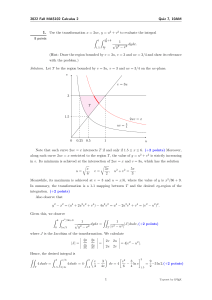MATH 101 MIDTERM 1, OCTOBER 6, 2004 x n
advertisement

MATH 101 MIDTERM 1, OCTOBER 6, 2004 n Z j X 1. Evaluate in closed form (x2 + x)dx. Z 2 Z 2 + 0 j−1 j=1 Z n +...+ 1 Z n (x2 + x)dx = ( = n−1 0 x3 n3 x2 n2 + )|n0 = + . 3 2 3 2 Z 4 (2 − x2 )dx, 2. Write the upper and lower Riemann sums approximating the integral 1 corresponding to the partition of [1, 4] into n intervals of equal length. (Indicate which is which. Do not try to evaluate the sums.) For a partition as indicated, we take ∆xj = 3/n, xj = 1 + (3j/n). The function 2 − x2 is decreasing for x > 0, so on each [xj−1 , xj ] the maximal and minimal values are attained at the left and right endpoints, respectively. Thus the upper Riemann sum is n X ∆xj · (2 − x2j−1 ) j=1 n X 3 3(j − 1) 2 · (2 − (1 + ) ), = n n j=1 and the lower Riemann sum is n X ∆xj · (2 − x2j ) = j=1 Z x2 −2x−1 3. Let F (x) = p n X 3j 3 · (2 − (1 + )2 ). n n j=1 t3 + 1dt. Find the equation of the line tangent to the graph of 2 F (x) at x = 3. Z 2 We have 3 −2·3−1 = 9−6−1 = 2, so F (3) = 2 t3 + 1dt = 0. Using the Fundamental 2 Theorem of Calculus we get F 0 (x) = p p (x2 − 2x − 1)3 + 1 · (2x − 2), √ √ so F 0 (3) = 23 + 1 · (2 · 3 − 2) = 9 · 4 = 12. Thus the tangent line has the equation y = 12(x − 3) = 12x − 36. 4. Evaluate the integrals: Z Z Z 3 2 2 2 (a) sin x cos x dx = (1 − cos x) cos x sin x dx = − (1 − u2 )u2 du Z = (u4 − u2 )du = u5 u3 cos5 x cos3 x − +C = − + C. 5 3 5 3 1 We used the substitution u = cos x, du = − sin x dx. (b) We substitute u = ln x, du = dx/x: Z tan2 (ln x) dx = x Z Z 2 tan u du = (sec2 u − 1)du = tan u − u + C = tan(ln x) − ln x + C. √ 5. Find the average value of f (x) = 9 − x2 on [0, 3]. (Hint: you may interpret the integral as an area of a planar region.) Z 3p The integral 9 − x2 dx is equal to the area of one quarter of the disc of radius 3, 0 centered at 0. The area of the entire disc is π · 32 = 9π. Thus the average value is 1 3 Z 3 p 9 − x2 dx = 0 3π 1 9π · = . 3 4 4 6. There are 2 finite planar regions bounded by the graphs of y = x3 − x2 + x and y = 3x. Find the area of each of them. We first find the x-coordinates of the intersection points: x3 −x2 +x = 3x, x3 −x2 −2x = 0, x = 0 or x2 − x − 2 = 0, i.e. x = 0, 2, −1. The first area is Z 0 −1 (x3 − x2 + x − 3x)dx = ( x4 1 1 x3 5 − − x2 )|0−1 = − − + 1 = , 4 3 4 3 12 and the second one is Z 2 (3x − x3 + x2 − x)dx = (− 0 x3 8 x4 16 8 + + x2 )|20 = − + + 4 = . 4 3 4 3 3 2






